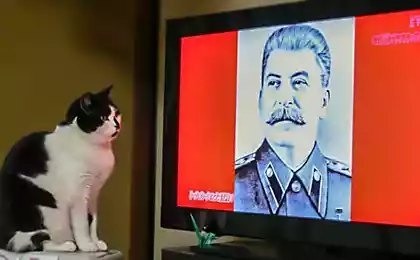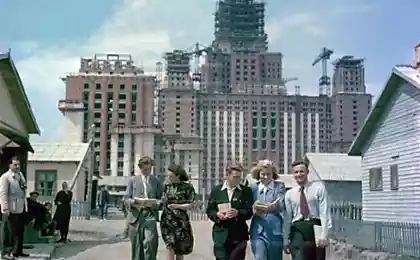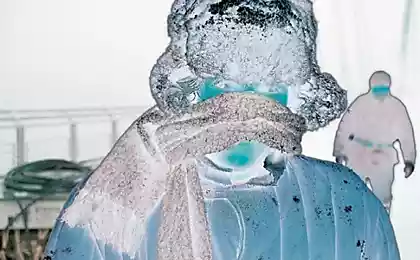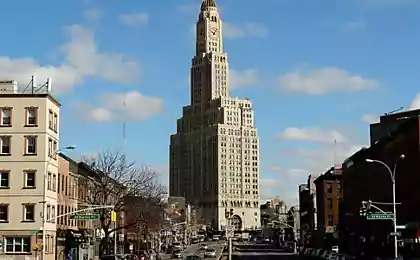2407
History of the building of Moscow State University (21 photos)
Construction of the main building of Moscow State University on Lenin (Sparrow) Hills in 1949-1953., Was one of the largest construction projects of the postwar Soviet Union.
The building of Moscow State University was the highest administrative and residential building in Moscow until the "Triumph Palace", and the highest in Europe, built up in 1990, Basler Messerturm in Frankfurt.
Height - 182 m, with a spire - 240 m, number of floors of the central building - 36.
Students of the school of young workers under construction on the background of the main building of Moscow State University (1951)

In 1948, employees of the department Party Central Committee, responsible science, received from the Kremlin job: study the issue of the construction of a new building for the MSU. Memoranda they had prepared together with the University Rector - academician AN Nesmeyanov proposing to build a "temple of Soviet science" skyscraper. From the Central Committee of the paper moved to the Moscow authorities. Soon Nesmeyanova and a representative of the "scientific" department of the Central Committee invited the City Party Committee: "Your idea is unrealistic. For high-rise elevators need too much. Therefore, the building must be not higher than the floor 4 ».

A few days later, Stalin held a special meeting on "university subject" and he announced his decision: to build the Moscow State University building height of not less than 20 floors atop Lenin Hills - to be seen from afar.

The project of the new building of the University was preparing a well-known Soviet architect Boris lofan who invented the skyscraper Palace of Soviets. However, a few days before the approval "at the top" of all the drawings of the architect of this work was suspended. Creating the largest of Stalin's skyscrapers was commissioned a group of architects led by LV Rudnev.

The reason for the sudden replacement of intransigence Iofana believe. He was going to build the main building just above the cliff Lenin Hills. But by the fall of 1948, experts have managed to convince Stalin that such an arrangement is fraught with huge buildings catastrophe: the area is dangerous in terms of landslides, and the new university simply will slide into the river! Stalin agreed with the need to transfer the main building of Moscow State University away from the edge of the Lenin Hills, but Iofana this option does not suit, and he was removed. Rudnev moved the building 800 meters deep into the territory, and the place chosen Iofanom created the observation deck.

The original sketch variant was supposed to crown skyscraper sculpture of impressive dimensions. Character sheets of drawing paper was depicted abstract - the figure of a man with a battened down his head to the sky and spread wide apart with his hands. Apparently, this posture should symbolize the desire for knowledge. Although the architects drawings showing Stalin hinted that the sculpture can get a portrait likeness to the leader. However, Stalin ordered to build a statue instead of the spire, the top part of the building of Moscow State University was similar to the other six high-rise buildings under construction in the capital.

The ceremony of laying the first stone of a high-rise building of Moscow State University April 12 of 1949, exactly 12 years before Gagarin's flight.
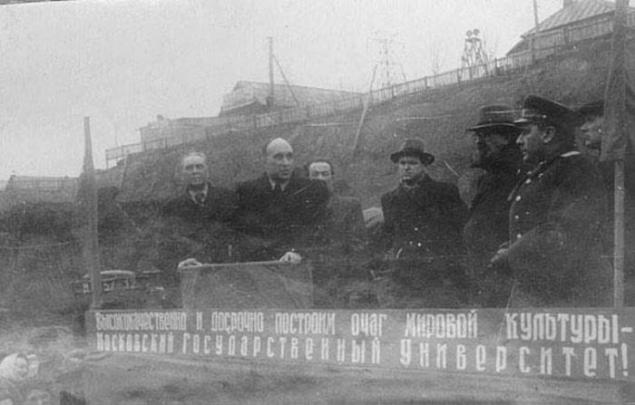
The reports from the impact of construction on the Lenin Hills was reported that the skyscraper erected 3000 Komsomol Stakhanovite. However, in reality there is a lot more people to work. Specifically, "a university" at the end of 1948 has been prepared by the Ministry of Interior ordered the conditional release of the camps of several thousand prisoners who had construction specialty. These cons were to spend the rest of the period on the construction of the Moscow State University.

The system of the Gulag existed "Construction-560", transformed in 1952 to the Office of the Special Region ITL (so-called "Stroylag"), which was engaged in the construction of a contingent of high-rise buildings of the university. He supervised the construction site, General Komorowski, Head of industrial construction camps. The number of prisoners in the "Stroylage" reached 14290 people. Almost all of them were sitting on the "domestic" articles "political" were afraid to drive to Moscow. Zone with watchtowers and barbed wire was built a few kilometers away from the "object", near the village of Ramenky in the area of the current prospectus Michurinsky.

When the construction of high-rise buildings coming to an end, it was decided to "bring your place of residence and work of prisoners." The new camp was equipped with a point right at the 24th and 25th floors of the towers under construction. This solution allows you to save and protection: there is no need of any guard towers, no barbed wire - is still nowhere to go.

As it turned out, the guards underestimated his mentoring contingent. They found among the prisoners craftsman that summer of 1952 built of plywood and wire some sort of hang glider and rumor ... Further events are treated differently. According to one version, he was able to fly to the other side of the Moscow River and escaped safely. On the other - it is still in the air, shot the guards. There is a variant with a happy end of the story: that the "Flyer" is already on the ground seized security officers, but when his act became known to Stalin personally ordered the courageous inventor release ... It is even possible that the cruise had two fugitives. At least, so says a civilian construction of skyscrapers, which he saw two people planning a tower on homemade wings. According to him, one of them shot, and the second left in the direction of Luzhniki.
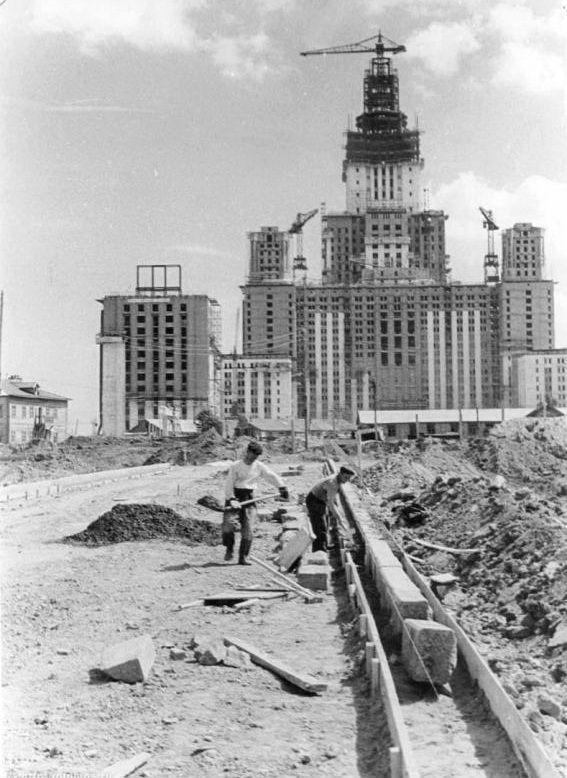
With a unique "high-altitude camp area" relates another unusual story. This incident was considered even if the assassination attempt on the leader of the people. One day the guards vigilant, checking the area "near-garden" in Kuntsevo Stalin, suddenly found on the track rifle bullet. Who shot? When? Turmoil was serious. We conducted ballistic examination and found that ... unfortunate bullet flew with the University under construction. In the course of further investigation it became clear picture of what happened. At the next changing of the guard, guards prisoners, one of the guards, handing over the post, pulled the trigger rifle in the trunk which proved to live round. A shot rang out. By law, meanness weapons appeared directed toward the government facility located far away, and the bullet still "fell short" to Stalin's dacha.

The main building of Moscow State University immediately broke many records. The height of a 36-storey high-rise buildings up to 236 meters. For the steel frame of the building it took 40 thousand tons of steel. And for the erection of walls and parapets it took nearly 175 million bricks. Spire has a height of about 50 meters, and crowning his star weighs 12 tons. On one side of a clock tower champions - the biggest in Moscow. Faces are made of stainless steel and have a diameter of 9 meters. The clock is also very impressive. Minute, for example, twice as long as the minute hand of the Kremlin chimes and has a length of 4, 1 meter and weighs 39 kilograms.

View from the building of Moscow State University, 1952 .:

The private sector in the area of construction.


Local residents were subject to resettlement.

Before the inauguration of "temple of science" September 1, 1953, Stalin did not live a few months. Had he lived a little longer, and Moscow State University would instead "Lomonosov Lomonosov "-" named after IV Stalin. " Plans for such a renaming took place. The change Vasilyevich Vissarionovich going to coincide in time for the start of the new building in the Lenin Hills. And in the winter '53 already prepared letters for the new name of the university, which was supposed to install a cornice over the main entrance of a tall building. But Stalin died and the project remained unfulfilled.

There are many myths about the main building of Moscow State University. So there is a version that before the meeting room of the Academic Council (the rector's office) located on the 9th floor of the four pillars of solid jasper, supposedly survived the demolition of the Cathedral of Christ the Savior, which is a myth, as in the ruined Temple of jasper columns were not.
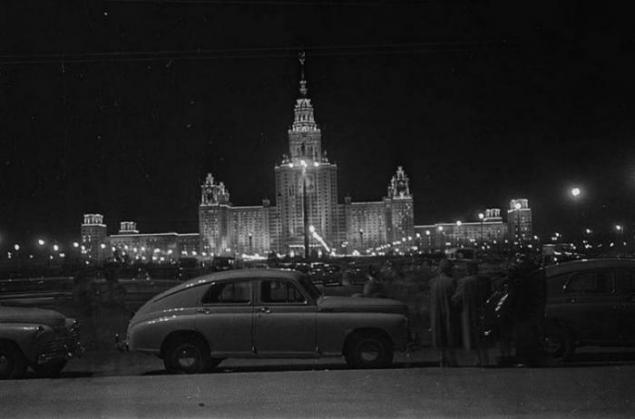
Sometimes referred to a rumor that the interiors of the building materials used in the ruined Reichstag, in particular rare pink marble. In fact, in the GB meets either white or red marble. However, the known fact that the body of the Faculty of Chemistry is equipped with a captured German hoods, which indirectly confirms the use of construction materials of German origin.
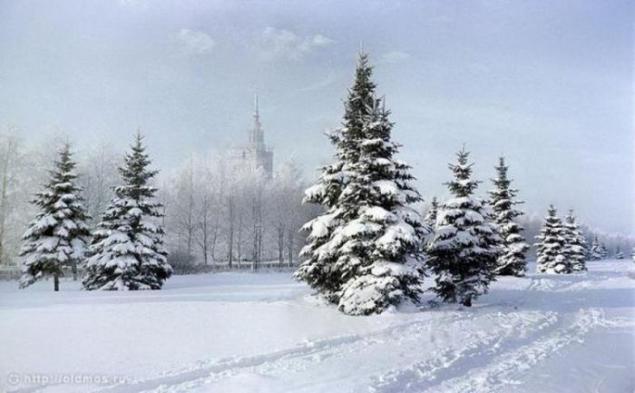
Outwardly, it seems that the spire and crowned him the star and ears covered with gold, but it is not. The spire, star, and ears not covered with gold - under the influence of wind and rain, gilding quickly come into disrepair. The spire, star, and ears are lined with yellow glass plates, the inside of the glass plates covered with aluminum. Currently, part of the glass parts collapsed and crumbled, if you look through binoculars, can be seen in various places gaping holes.

Source: ihoraksjuta.livejournal.com
The building of Moscow State University was the highest administrative and residential building in Moscow until the "Triumph Palace", and the highest in Europe, built up in 1990, Basler Messerturm in Frankfurt.
Height - 182 m, with a spire - 240 m, number of floors of the central building - 36.
Students of the school of young workers under construction on the background of the main building of Moscow State University (1951)

In 1948, employees of the department Party Central Committee, responsible science, received from the Kremlin job: study the issue of the construction of a new building for the MSU. Memoranda they had prepared together with the University Rector - academician AN Nesmeyanov proposing to build a "temple of Soviet science" skyscraper. From the Central Committee of the paper moved to the Moscow authorities. Soon Nesmeyanova and a representative of the "scientific" department of the Central Committee invited the City Party Committee: "Your idea is unrealistic. For high-rise elevators need too much. Therefore, the building must be not higher than the floor 4 ».

A few days later, Stalin held a special meeting on "university subject" and he announced his decision: to build the Moscow State University building height of not less than 20 floors atop Lenin Hills - to be seen from afar.

The project of the new building of the University was preparing a well-known Soviet architect Boris lofan who invented the skyscraper Palace of Soviets. However, a few days before the approval "at the top" of all the drawings of the architect of this work was suspended. Creating the largest of Stalin's skyscrapers was commissioned a group of architects led by LV Rudnev.

The reason for the sudden replacement of intransigence Iofana believe. He was going to build the main building just above the cliff Lenin Hills. But by the fall of 1948, experts have managed to convince Stalin that such an arrangement is fraught with huge buildings catastrophe: the area is dangerous in terms of landslides, and the new university simply will slide into the river! Stalin agreed with the need to transfer the main building of Moscow State University away from the edge of the Lenin Hills, but Iofana this option does not suit, and he was removed. Rudnev moved the building 800 meters deep into the territory, and the place chosen Iofanom created the observation deck.

The original sketch variant was supposed to crown skyscraper sculpture of impressive dimensions. Character sheets of drawing paper was depicted abstract - the figure of a man with a battened down his head to the sky and spread wide apart with his hands. Apparently, this posture should symbolize the desire for knowledge. Although the architects drawings showing Stalin hinted that the sculpture can get a portrait likeness to the leader. However, Stalin ordered to build a statue instead of the spire, the top part of the building of Moscow State University was similar to the other six high-rise buildings under construction in the capital.

The ceremony of laying the first stone of a high-rise building of Moscow State University April 12 of 1949, exactly 12 years before Gagarin's flight.

The reports from the impact of construction on the Lenin Hills was reported that the skyscraper erected 3000 Komsomol Stakhanovite. However, in reality there is a lot more people to work. Specifically, "a university" at the end of 1948 has been prepared by the Ministry of Interior ordered the conditional release of the camps of several thousand prisoners who had construction specialty. These cons were to spend the rest of the period on the construction of the Moscow State University.

The system of the Gulag existed "Construction-560", transformed in 1952 to the Office of the Special Region ITL (so-called "Stroylag"), which was engaged in the construction of a contingent of high-rise buildings of the university. He supervised the construction site, General Komorowski, Head of industrial construction camps. The number of prisoners in the "Stroylage" reached 14290 people. Almost all of them were sitting on the "domestic" articles "political" were afraid to drive to Moscow. Zone with watchtowers and barbed wire was built a few kilometers away from the "object", near the village of Ramenky in the area of the current prospectus Michurinsky.

When the construction of high-rise buildings coming to an end, it was decided to "bring your place of residence and work of prisoners." The new camp was equipped with a point right at the 24th and 25th floors of the towers under construction. This solution allows you to save and protection: there is no need of any guard towers, no barbed wire - is still nowhere to go.

As it turned out, the guards underestimated his mentoring contingent. They found among the prisoners craftsman that summer of 1952 built of plywood and wire some sort of hang glider and rumor ... Further events are treated differently. According to one version, he was able to fly to the other side of the Moscow River and escaped safely. On the other - it is still in the air, shot the guards. There is a variant with a happy end of the story: that the "Flyer" is already on the ground seized security officers, but when his act became known to Stalin personally ordered the courageous inventor release ... It is even possible that the cruise had two fugitives. At least, so says a civilian construction of skyscrapers, which he saw two people planning a tower on homemade wings. According to him, one of them shot, and the second left in the direction of Luzhniki.

With a unique "high-altitude camp area" relates another unusual story. This incident was considered even if the assassination attempt on the leader of the people. One day the guards vigilant, checking the area "near-garden" in Kuntsevo Stalin, suddenly found on the track rifle bullet. Who shot? When? Turmoil was serious. We conducted ballistic examination and found that ... unfortunate bullet flew with the University under construction. In the course of further investigation it became clear picture of what happened. At the next changing of the guard, guards prisoners, one of the guards, handing over the post, pulled the trigger rifle in the trunk which proved to live round. A shot rang out. By law, meanness weapons appeared directed toward the government facility located far away, and the bullet still "fell short" to Stalin's dacha.

The main building of Moscow State University immediately broke many records. The height of a 36-storey high-rise buildings up to 236 meters. For the steel frame of the building it took 40 thousand tons of steel. And for the erection of walls and parapets it took nearly 175 million bricks. Spire has a height of about 50 meters, and crowning his star weighs 12 tons. On one side of a clock tower champions - the biggest in Moscow. Faces are made of stainless steel and have a diameter of 9 meters. The clock is also very impressive. Minute, for example, twice as long as the minute hand of the Kremlin chimes and has a length of 4, 1 meter and weighs 39 kilograms.

View from the building of Moscow State University, 1952 .:

The private sector in the area of construction.


Local residents were subject to resettlement.

Before the inauguration of "temple of science" September 1, 1953, Stalin did not live a few months. Had he lived a little longer, and Moscow State University would instead "Lomonosov Lomonosov "-" named after IV Stalin. " Plans for such a renaming took place. The change Vasilyevich Vissarionovich going to coincide in time for the start of the new building in the Lenin Hills. And in the winter '53 already prepared letters for the new name of the university, which was supposed to install a cornice over the main entrance of a tall building. But Stalin died and the project remained unfulfilled.

There are many myths about the main building of Moscow State University. So there is a version that before the meeting room of the Academic Council (the rector's office) located on the 9th floor of the four pillars of solid jasper, supposedly survived the demolition of the Cathedral of Christ the Savior, which is a myth, as in the ruined Temple of jasper columns were not.

Sometimes referred to a rumor that the interiors of the building materials used in the ruined Reichstag, in particular rare pink marble. In fact, in the GB meets either white or red marble. However, the known fact that the body of the Faculty of Chemistry is equipped with a captured German hoods, which indirectly confirms the use of construction materials of German origin.

Outwardly, it seems that the spire and crowned him the star and ears covered with gold, but it is not. The spire, star, and ears not covered with gold - under the influence of wind and rain, gilding quickly come into disrepair. The spire, star, and ears are lined with yellow glass plates, the inside of the glass plates covered with aluminum. Currently, part of the glass parts collapsed and crumbled, if you look through binoculars, can be seen in various places gaping holes.

Source: ihoraksjuta.livejournal.com
